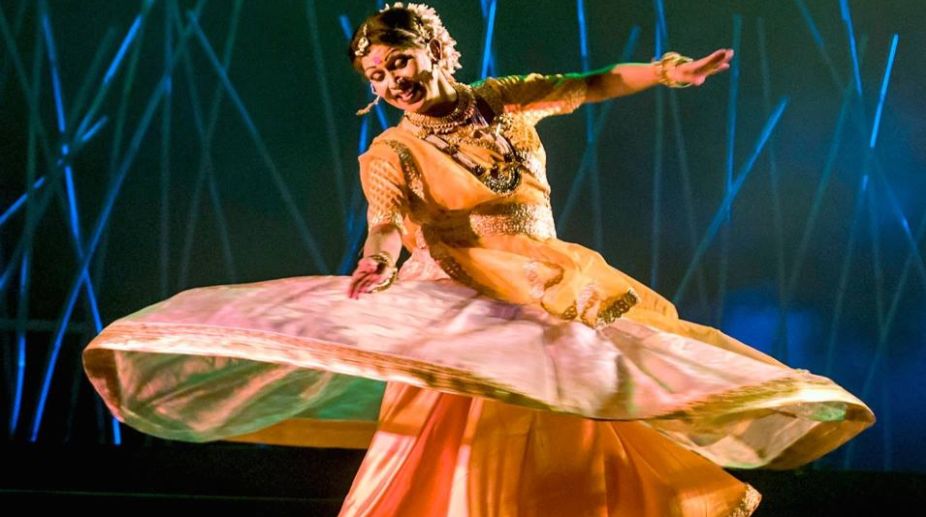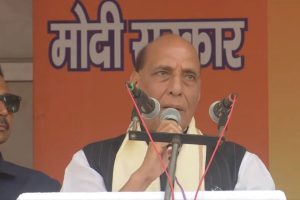As the Lalit Arpan Festival culminated in the city, celebrating the hues of rich and vibrant traditional art forms, Padmashri awardee and renowned Kathak Guru Shovana Narayan gets nostalgic on her journey so far, in an interview with Kunal Roy.
Excerpts:
You are India’s most celebrated Kathak maestro. Tell us about your childhood and journey till date.
The journey till date has been beautiful with life’s usual ups and downs through challenges that usually come in everyone’s path as they teach a lot and help in development of the person. Initiated into the world of Kathak when I was not yet three-years-old, I was fortunate to have received training from three great Gurus: Sadhona Bose (the eminent dancer and actress of yester-years, who was the grand-daughter of social reformer Keshab Chandra Sen) at Calcutta, Guru Kundan Lal (Sisodia) at Bombay and Pt Birju Maharaj at Delhi, from whom I learnt from 1964 onwards. My first stage experience at the age of four helped me get over stage fright.
My performance at Bombay’s Shanmukhanand Hall in 1970-71 without my Guru Birju Maharaj conducting the programme, was a test in conducting and carrying the programme on one’s own shoulder as also a lesson in how to engage the audience’s interest with the classicality of my programme. I studied Physics and then later joined the Civil Services.
All through dance was there for it was my breath and I was getting recognition as a dancer in the eyes of the public and connoisseurs. I was also fortunate to grow up in an environment, where Hindi, Sanskrit, Vedic literature and Indian philosophy were part of my upbringing, where our house saw several litterateurs and socially motivated people.
All these left their imprint and helped in my personal development.
Everyone knows that apart from being a Kathak Guru, Shovana Narayan is also a scholar and a successful civil servant. What was your mantra to manage government files and stage performances?
I was extremely focussed in what I did. My mother had ingrained into me to be dedicatedly working on whatever I was handling or doing and not allow overlapping of activities. This held me in good stead. When I was in office, I was an officer but after office hours I was a dancer.
There were so many occasions when my car would be packed with musical instruments and costumes and immediately after leaving office, an hour or two later I would be on stage in Kamani or FICCI or IIC or Siri Fort for my performance in some dance festival or the other. Maximum utilisation was made of government holidays and weekends to do all my outstation performances.
Another good advice that I received from Dr Kapila Vatsyayan when I was about to enter Civil Services was to stay away from postings in ministries that had anything to do with dance, culture. This I followed scrupulously.
You are also known to have trained many popular young Kathak dancers. How satisfying is that at a personal level to impart the art to the next generation?
I have been clear that I should be able to impart not only technical skills and ethos of the dance form to my disciples but also that they should be able to be a dancer on their own merit with their own identity and that they should understand dance in all its dimensions, but also not losing sight of humanity and sensitivity. Hence, it is personally lovely for me to see that they are doing so well carving out their own niche in the world of dance.
What is the essence of being Shovana?
That is for the others to see and analyse. As far as I am concerned I have been myself and I continue to be myself, dedicatedly serving dance and expressing my feelings and emotions through my works. I do what my heart responds to.
You hold a Doctorate in Physics, which requires extensive research. Does Kathak require such heavy research as well?
It depends on how you see a form and how you approach a form. For me it was important to be very skilled with depth and understanding of Kathak, be it in rhythmic virtuosity or in Abhinaya, wherein the latter requires understanding of the text, the sahitya. Herein my growing up period with Sanskrit and Hindi literature and Indian phiolosophy helped.
In addition to it, I do have a questioning mind as to why there were so many misconceptions about the term Kathak and several aspects of the dance form that naturally also led me to delve deeper. But such an approach is very personal to each individual.
Do Bollywood or mainstream dance forms put a dent on our traditional art forms? What is your opinion?
Each art form has its own space. Even in the past ages there would have been popular arts of that period. But classical art forms, with their thousands of years’ tradition, have swum and survived through the popular art forms of different ages. Take Kathak, for instance. This has been mentioned in three sections of the Mahabharata as well as in a 4th century BC, Prakrit inscriptions both of which take its history back to over 2,500 years, well predating the Natyashastra.
Despite various onslaughts and changing socio political environment, the dance form continues to be practised today exuding vibrancy and dynamism.
Do you believe our younger generation is losing their hold over traditional art forms? What is your view?
I personally think we should look towards the parents of the younger generations and the kind of ambitions that they have. The home environment is reflected in the kind of rooting, nurturing and development of the personality takes place, which also reflects in the projections around. If the roots of the child are strongly entrenched in one’s own culture while understanding and appreciating all cultures of the world, it helps the child’s development with a balanced personality.
If one looks around, violence is not associated with artistes of classical genres. These artistes, while being grounded in their own traditions, are yet fine examples of global citizens. Classical arts give a sense of inner harmony and peace, and which many people realize and turn towards being ‘rasikas’ later in their lives.
What qualities would you ascribe to a woman of substance?
Any person who is able to face challenges and overcome obstacles smilingly, through sheer hard work and dedication, carving out a niche for themselves in whatever their circumstances are and in whatever they are doing, is an achiever. After all, even a poor person, who may be a victim of Tsunami or some such natural disasters, and is able to build his or her own life again, is an achiever.
What in your view can popularize Indian art culture, and give dance forms like Kathak more mass appeal?
Popular mass appeal, in my personal view, should not be the criteria. What is important is the honing of sensitivity and the judiciousness to understand and appreciate the differences between various art forms.











